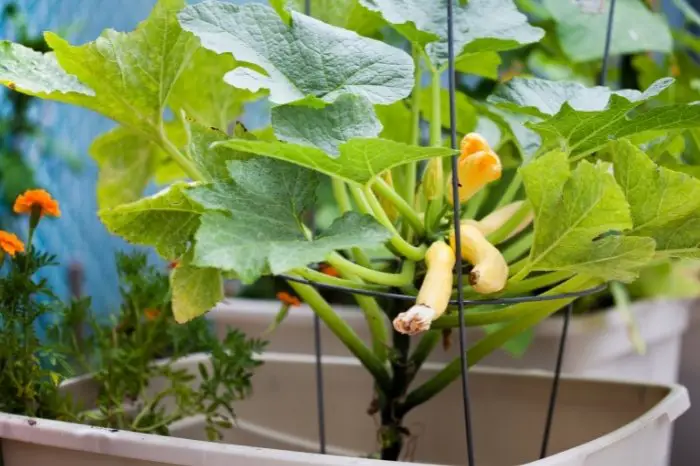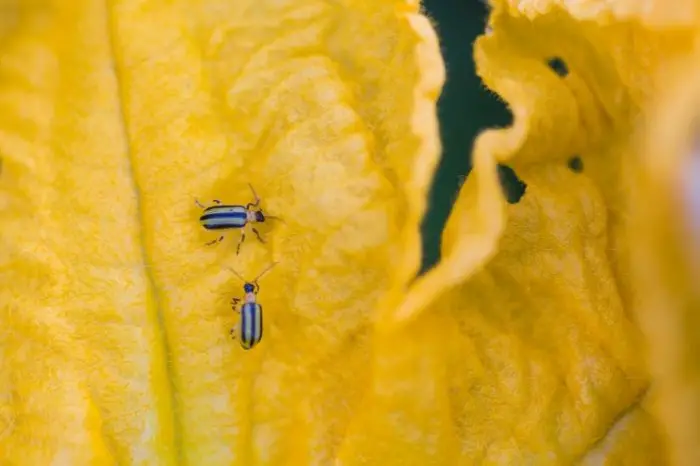Last Updated on February 10, 2022
Growing yellow squash is an option for a healthy garden. Yellow squash is a rich versatile vegetable and one of the species of summer squash. It is a vegetable that grows fast, rich in vitamins, and can be used to make cheesy casseroles, a healthy pasta substitute, and even baked parmesan bites.
Growing yellow squash may be a little tricky to grow as the plant require a varying amount of nutrients and may be easily affected by pests and diseases. It is therefore important that you take note of a few vital points when planting and growing yellow squash so as to attain the best result.
This article gives you a guide on the things you should note when planting and growing yellow squash. The best time to plant in the year and the likely time to expect harvest are all covered here. A few practices to adopt so as to prevent pests and diseases from attacking the plants are here also.
Now let’s begin with things you should note when planting and growing yellow squash.
Tips On Planting Yellow Squash
The following are some important planting conditions you should take note of when planting yellow squash:
Yellow Squash Grows Better In The Summer
This plant is highly susceptible to cold and as such does not do well in cold soil or frost. It is, therefore, best to plant in the middle or towards the end of spring when the temperature is about 65 degrees Fahrenheit. From mid-March to April is the best time for early harvest, while from late July through August is the best time for fall harvest.
It Requires A Lot Of Sunlight
This vegetable requires a lot of sunshine for the best possible result to be attained. Planting Yellow squash in a shady place or under an umbrella tree or plant will not yield the best result. Ensure the plant receives about eight hours of sunlight daily.
Click Here to Learn:
Pick A Location That Drains Water Well
Yellow squash does not do well in a place where water is accumulated. This is bad for the root and may lead to root rot which may ultimately kill the plant. Avoid low grounds and water accumulated sites when planting.
pH Soil Levels
For yellow squash to do well, the pH level of the soil should be between 6.0 and 6.5. Where this level is not the case for your garden, take steps to augment it accordingly. You should take steps to check your soil pH level from time to time.
Luster Leaf 1601 Rapitest Test Kit for Soil pH, Nitrogen, Phosphorous, and Potash
Support Your Soil With More Nutrients
Squash is considered to be a heavy feeder, and this implies that it requires a lot of nutrients to thrive. As such, improve your soil with organic compost and natural, slow-release fertilizer before and after planting. You should however be careful not to use fertilizers with lots of nitrogen as this encourages leaf growth which may be good for a young plant, but not at the fruit-giving stage.
Check Out A Guide On Saving And Growing Persian Cucumber Seeds
How To Plant Yellow Squash – Growing Yellow Squash
You can do the following when planting yellow squash:
- Prepare the Soil: You do this by confirming the soil pH level, ensuring water drains well from the soil, and adding the relevant nutrients to boost the soil.
- Sow Seeds: Two or three seeds should be sown every nine to twelve inches. The depth of the seed should be between 1 and 1.5 inches into the soil. When planting seeds, ensure the temperature is about 65 to 70 degrees Fahrenheit since the plant is frost-sensitive.
- Cover the Seeds: After planting, you should cover them slightly with a mulch. This could be straw, wood chips, or dried leaves. This helps to keep the weeds down and maintain the soil moisture pending when the plant begins to grow leaves.
- Keep Soil Moist: During the germination period, keep the soil moist and water regularly. Ensure to be careful when watering so as to prevent leaf diseases. It’s best to water at ground level and not directly on leaves.

- Thinning: Yellow squash usually spread and cover available space easily. As such, you should thin to the strongest single seedling of the 2 or 3 you planted in each group.
- Harvesting: It all depends on the desired result. “Scallop” yellow squashes are best picked when they are between 3 to 5 inches across, while “Crookneck” and “Straightneck” are best left until they are about 4 to 7 inches. If you delay harvesting early enough, the skin may become thick and tough, with dense interior seed pockets.
Common Pests And Diseases That Affect Yellow Squash
Yellow squash is often affected by a wide array of pests and diseases. As such, extra care must be taken when growing the plant. They are plagued by squash bugs, cucumber beetles, squash vine borers, slugs, and snails. In addition to these, sap-sucking whiteflies and aphids are pests to the plant.
Yellow squash is also affected by diseases like mosaic viruses, squash blossom blight, and cucumber bacterial wilt. It is therefore imperative that you regularly check the plant to ensure that they are not disturbed by any of these diseases or pests. Treat swiftly once you notice any of the above.
Different ways are adopted when dealing with these pests and diseases. For example, squash bugs usually become active and lay their eggs in early spring. Squash visible eggs laid on the stem of the plant and use pesticides to eliminate those that are laying eggs or have hatched.

In the case of cucumber beetles, mulching the ground with stray, hay or any other item is a good way to deter the beetles from laying eggs. Also, by planting cucurbits later in the season, you are sure to scare the beetles away.
Growing Yellow Squash: Final Say
Growing yellow squash is a bit intricate as you have seen from above. You must therefore be willing to give the requisite attention when growing yellow squash. Ensure to plant at the right time and in well-prepared soil. These are factors that will likely improve the result obtained.
This plant like some other plants is susceptible to pests and diseases. Therefore, this means that you must put into consideration some necessary precautions to deal with these diseases.
FAQ’s
Why is my yellow squash growing deformed?
There are different reasons why your yellow squash may be growing deformed. Some of these reasons include pest infection, boring insects, excess calcium in the soil, or the result of a disease, more likely a mosaic virus.
Why are my yellow squash growing small?
If you are having problems with the size of your yellow squash, and the plant does produce ample flowers, then you are dealing with a pollination issue. So, you need pollination or a physical transfer of pollen from male flowers to female flowers, usually by bees. If this is not happening, then you will have issues with the size of your fruit.
When to start growing yellow squash from seed?
From mid-March to April is the best time to plant from seed for early harvest, while from late July through August is the best time to plant from seed for fall harvest.
How long does it take to grow yellow squash?
It usually takes between 45 to 60 days from planting to harvest for most varieties of yellow squash.

Eunice is an enthusiastic gardener with a passion for growing beautiful flowers. She loves nothing more than spending time in her garden, tending to her plants and enjoying the outdoors. Eunice has been gardening for over 15 years and has developed a unique style of landscaping that is both practical and aesthetically pleasing. She is especially fond of growing roses and enjoys experimenting with different varieties and colors. Eunice takes great pride in her garden and often shares the fruits of her labor with friends and family. In her spare time, she enjoys reading gardening magazines and attending local horticulture events. Eunice is passionate about her hobby and is always eager to share her knowledge and experience with others.

